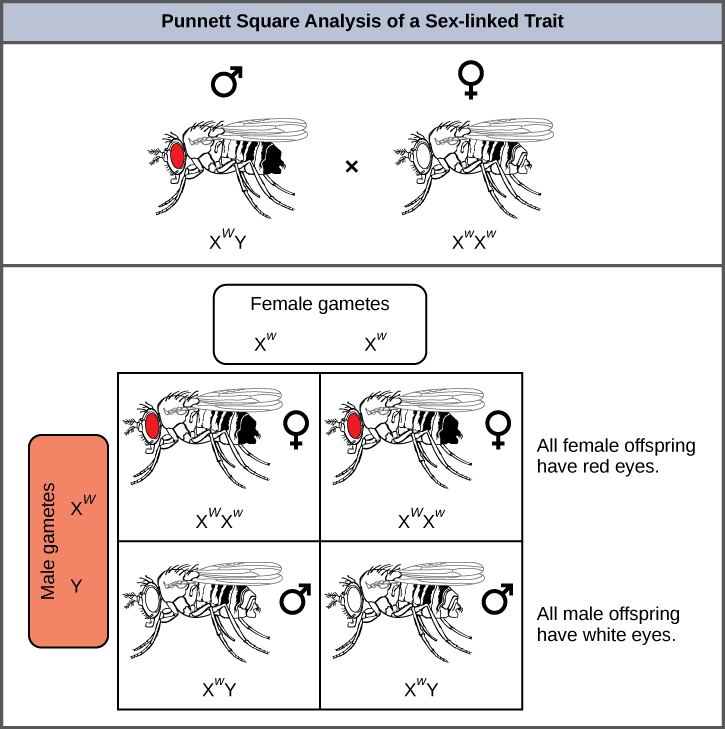| << Chapter < Page | Chapter >> Page > |
In humans, as well as in many other animals and some plants, the sex of the individual is determined by sex chromosomes—one pair of non-homologous chromosomes. Until now, we have only considered inheritance patterns among non-sex chromosomes, or autosomes. In addition to 22 homologous pairs of autosomes, human females have a homologous pair of X chromosomes, whereas human males have an XY chromosome pair. Although the Y chromosome contains a small region of similarity to the X chromosome so that they can pair during meiosis, the Y chromosome is much shorter and contains fewer genes. When a gene being examined is present on the X, but not the Y, chromosome, it is X-linked .
Eye color in Drosophila , the common fruit fly, was the first X-linked trait to be identified. Thomas Hunt Morgan mapped this trait to the X chromosome in 1910. Like humans, Drosophila males have an XY chromosome pair, and females are XX. In flies the wild-type eye color is red (X W ) and is dominant to white eye color (X w ) ( [link] ). Because of the location of the eye-color gene, reciprocal crosses do not produce the same offspring ratios. Males are said to be hemizygous, in that they have only one allele for any X-linked characteristic. Hemizygosity makes descriptions of dominance and recessiveness irrelevant for XY males. Drosophila males lack the white gene on the Y chromosome; that is, their genotype can only be X W Y or X w Y. In contrast, females have two allele copies of this gene and can be X W X W , X W X w , or X w X w .

In an X-linked cross, the genotypes of F 1 and F 2 offspring depend on whether the recessive trait was expressed by the male or the female in the P generation. With respect to Drosophila eye color, when the P male expresses the white-eye phenotype and the female is homozygously red-eyed, all members of the F 1 generation exhibit red eyes ( [link] ). The F 1 females are heterozygous (X W X w ), and the males are all X W Y, having received their X chromosome from the homozygous dominant P female and their Y chromosome from the P male. A subsequent cross between the X W X w female and the X W Y male would produce only red-eyed females (with X W X W or X W X w genotypes) and both red- and white-eyed males (with X W Y or X w Y genotypes). Now, consider a cross between a homozygous white-eyed female and a male with red eyes. The F 1 generation would exhibit only heterozygous red-eyed females (X W X w ) and only white-eyed males (X w Y). Half of the F 2 females would be red-eyed (X W X w ) and half would be white-eyed (X w X w ). Similarly, half of the F 2 males would be red-eyed (X W Y) and half would be white-eyed (X w Y).

Discoveries in fruit fly genetics can be applied to human genetics. When a female parent is homozygous for a recessive X-linked trait, she will pass the trait on to 100 percent of her male offspring, because the males will receive the Y chromosome from the male parent. In humans, the alleles for certain conditions (some color-blindness, hemophilia, and muscular dystrophy) are X-linked. Females who are heterozygous for these diseases are said to be carriers and may not exhibit any phenotypic effects. These females will pass the disease to half of their sons and will pass carrier status to half of their daughters; therefore, X-linked traits appear more frequently in males than females.

Notification Switch
Would you like to follow the 'Principles of biology' conversation and receive update notifications?